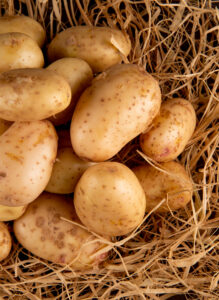Potatoes are a staple in American diets, celebrated for their versatility and deliciousness. However, you might wonder: Are potatoes actually good for you? The simple answer is that potatoes can indeed be a healthy choice when prepared properly.
A medium-sized potato is not only a great source of fiber but also low in calories. Potatoes are complex carbohydrates, making them an excellent addition to a balanced diet. Here’s an in-depth look at the benefits of potatoes and the best ways to prepare them to maximize their nutritional value.
Types of Potatoes
There are several types of potatoes available in the United States, each with unique characteristics:
- Blue/Purple: These potatoes get their distinctive color from antioxidants and can be used in various dishes.
- Fingerling: Fingerling potatoes are shaped like fingers, come in different colors, and have low starch content.
- New: Also known as baby potatoes, they have minimal starch and are ideal for potato salads.
- Red: Red potatoes have a slightly sweet taste and a medium starch level.
- Russet: Known for their high starch content, Russet potatoes are perfect for mashed and baked potatoes.
- Sweet: These potatoes, which can be orange, white, or purple, are sweeter and versatile in many meals.
- Yellow: Yellow potatoes have a rich, buttery flavor, suitable for numerous dishes.
Health Benefits of Potatoes
Potatoes offer several health benefits, from enhancing exercise performance to aiding weight management.
Rich in Antioxidants
Potatoes are packed with antioxidants, which help prevent cell damage and may reduce the risk of certain diseases. Key antioxidants in potatoes include:
- Carotenoids
- Patatin (a storage protein)
- Phenolic antioxidants (phenolic acids and flavonols)
- Vitamins B1, B6, B9, C, and E
Supports Exercise Performance
The carbohydrates and nutrients in potatoes make them an excellent energy source for exercise. A study comparing potato purée to a commercial carbohydrate gel during prolonged cycling found that both provided similar performance benefits. Both the purée and gel stabilized blood glucose levels, were easily digested, and enhanced workout performance.
Aids in Weight Management
Potatoes contain fiber and resistant starch—a unique carbohydrate that your body cannot digest. Resistant starch promotes satiety, helping you feel full longer, which can prevent overeating and aid in weight management.
Nutritional Content of Potatoes
Here’s the nutritional breakdown of a medium-sized raw Russet potato with skin:
- Calories: 168
- Fat: <1 gram
- Sodium: 10.6 milligrams
- Carbohydrates: 38.6 grams
- Fiber: 2.77 grams
- Protein: 4.56 grams
For a baked potato with skin, the nutrition is slightly different:
- Calories: 164
- Fat: <1 gram
- Sodium: 24.2 milligrams
- Carbohydrates: 37 grams
- Fiber: 3.98 grams
- Protein: 4.55 grams
Potential Risks of Eating Potatoes
While potatoes can be healthy, certain preparations can diminish their benefits. For instance, loading a baked potato with cheese, sour cream, butter, and bacon adds excessive sodium and saturated fat, which should be consumed in moderation.
White potatoes, when warmed, can cause blood sugar spikes due to their high glycemic index, affecting blood sugar levels rapidly.
Tips for Consuming Potatoes
To get the most nutritional value from potatoes:
- Storage: Keep potatoes in a cool, dry place and discard any that have gone bad to prevent them from spoiling the rest.
- Cooking Methods: Nutrient retention is higher in potatoes cooked using dry methods like microwaving or grilling compared to wet methods like boiling or steaming. Boiling potatoes with the skin on also helps preserve their nutrients.
- Temperature: Cooling potatoes after cooking increases their resistant starch content.
Potatoes can be enjoyed in a variety of ways:
- Add cooked, chilled potatoes (like fingerling, red-skinned, or sweet potatoes) to salads or as a side dish.
- Include them in breakfast dishes, such as a veggie scramble.
- Use potatoes in sweet recipes like smoothies or potato cakes.
- Incorporate them into veggie chili, soups, or stews.
- Use sliced potatoes as the base for a baked frittata.
- Stuff baked potatoes with oven-roasted or sautéed veggies and lean protein.
By preparing potatoes thoughtfully, you can enjoy their delicious taste while reaping their numerous health benefits.












